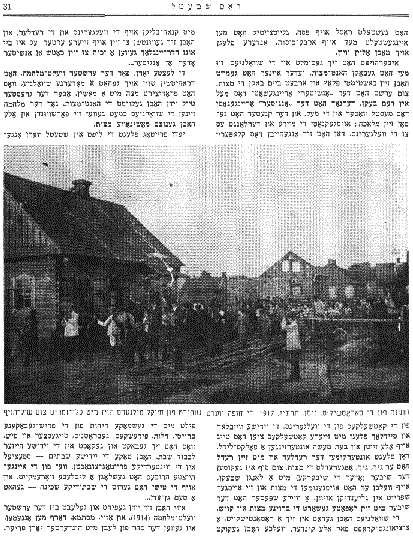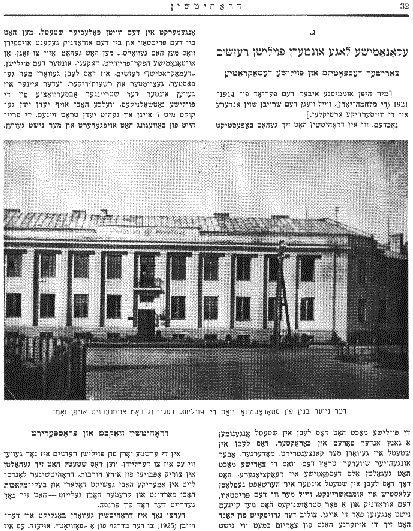Previous Page
|
Next Page
 [
Page 31
]
[
Page 31
]
made brine for Passover. At the same time, they made honey wine for the four
cups of Seder wine. Some people made grape wine themselves.
The workshops were bustling at
this time, because these workshops were the places where hand-made matzahs were
baked. Every person had to have his own assigned place and task in the matzah
production process.
First, one person set up the
baking equipment, then someone else added the measured amount of water to the
flour, and a third person started kneading the dough and then turned it over to
the person who rolled the dough. After that, someone punched the dough. Jewish
women and girls would pull and pound the dough from all sides, and spend the
time humming a folksong. The next person would start rapidly poking the
matzahs. Finally, a man or woman would use a long stick to slide the matzahs
into the glowing hot oven. A while later, that person would place the brown
baked matzahs into a basket.
Those workshops had a romantic
air about them, a magnetic force that attracted all the children, who jealously
watched the kneaders and the rollers do their work. The children just wished
they could be right there and participate. It was a real privilege if any of us
children was able to participate.
In the final years before World
War I, Drohitchin also had a modern matzah factory, which produced machine-made
matzahs. Most of the Jews, however, preferred the hand-made ones. After the
war, however, almost all the matzah workshops disappeared, and everyone used
machine matzahs.
[Photo:] The Saratshick
wedding, 1917. The wedding canopy is being brought from Chaikel Milner's house
to the Synagogue courtyard, accompanied by music.
Every Friday, the air in town
was filled with the aroma of freshly baked bread, challahs, pirogues, roast,
puddings and fish, which was being cooked and baked in Jewish homes in honor of
the Sabbath. Actually, the food of the Jewish Sabbath had the taste of
paradise, especially during the long Friday evenings, when the stoves gave off
an affable warmth, and the Divine Presence hovered over the Sabbath table.
This is the way things were
before World War I (1914), and probably the way things were for hundreds of
years before that.
 [
Page 32
]
[
Page 32
]
C.
ECONOMIC CONDITIONS UNDER THE POLISH REGIME
Czarist despotism and Polish democracy
(We're leaving out the period from 1914-1921 (war years) because others are
writing about it later in the book)
[Photo:] The new municipal building built by the Polish government on the Sand]
After Polish authority established itself in Drohitchin, life took on an
entirely different character. Life became more concentrated and modernized, but
also more difficult. Even though the Czarist regime was despotic and
reactionary regime, life in town under it was actually quite flexible and open.
This was because apart from the police commissioner, the local governor and a
couple of policemen, nobody was around. The fact that the Czarist empire was so
large meant that the czarist iron hand was almost totally unnoticed in the
faraway
shtetl
in Polesia. People were able to get the commissioner and the governor to do
practically anything they wanted them to do. It was sort of a non-authoritarian
situation. On the other hand, under the Polish "democratic" regime,
life became restricted, contained and mean. Everybody was under the watchful
eye of the Polish officials who watched every Jew with seven eyes and every
step a Jew took. There was no more freedom of movement.
Drohitchin grew and prospered
During the first years of the Polish regime, the situation was still tolerable.
When the town had to stop building its ruins, former residents of Drohitchin in
the United States would send money, and craftsmen and storekeepers still made a
living – the economy still hummed along.
Later on, in 1925, Drohitchin was promoted to the level of a district [
uyezd
]. A local official
Previous Page
|
Next Page
This material is made available by JewishGen, Inc.
and the Yizkor Book Project for the purpose of
fulfilling our
mission of disseminating information about the Holocaust and
destroyed Jewish communities.
This material may not be copied,
sold or bartered without JewishGen, Inc.'s permission. Rights may be
reserved by the copyright holder.
JewishGen, Inc. makes no representations regarding the accuracy of
the translation. The reader may wish to refer to the original material
for verification.
JewishGen is not responsible for inaccuracies or omissions in the original work and cannot rewrite or edit the text to correct inaccuracies and/or omissions.
Our mission is to produce a translation of the original work and we cannot verify the accuracy of statements or alter facts cited.
 Drogichin, Belarus
Drogichin, Belarus
 Yizkor Book Project
Yizkor Book Project
 JewishGen Home Page
JewishGen Home Page
Yizkor Book Director, Lance Ackerfeld
This web page created by Lance Ackerfeld
Copyright © 1999-2025 by JewishGen, Inc.
Updated 3 Dec 2001 by LA
 [
Page 31
]
[
Page 31
]



